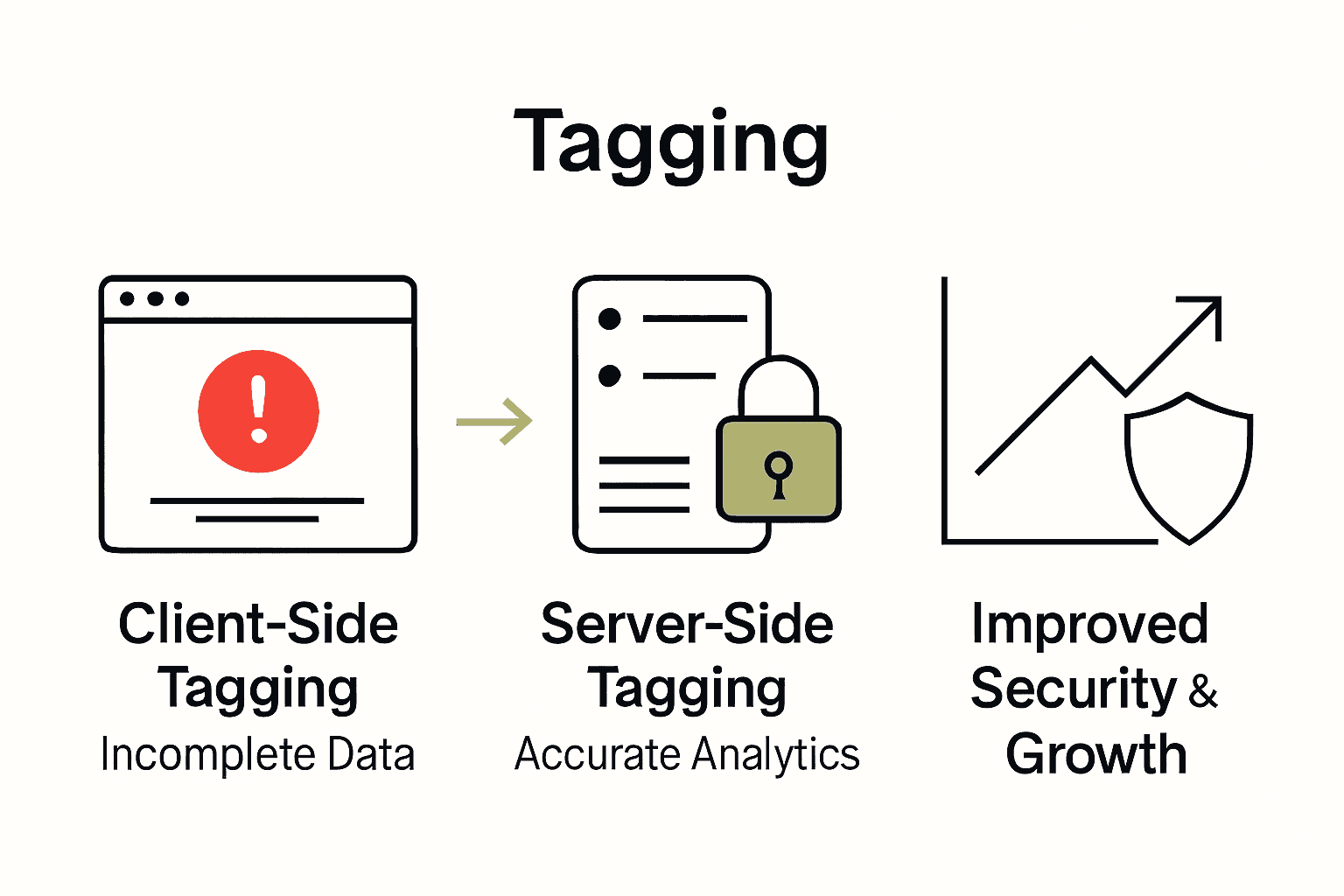Most businesses collect mountains of e-commerce data but miss the real story hidden in the numbers. Understanding which metrics truly matter can shape everything from marketing success to long-term customer loyalty. Nearly 80 percent of online businesses report confusion when interpreting key performance indicators. This article clears up common misconceptions and shows how choosing and applying the right metrics will help you spot growth opportunities and avoid costly mistakes.
Table of Contents
- Defining E-Commerce Metrics And Misconceptions
- Key Types Of Metrics And Their Roles
- How Server-Side Tagging Impacts Analytics
- Data Compliance, Consent, And Privacy Concerns
- Common Mistakes And How To Avoid Them
Key Takeaways
| Point | Details |
|---|---|
| Understanding E-Commerce Metrics | E-commerce metrics are categorized into business, traffic, conversion, and audience involvement metrics, which are crucial for strategic decision-making. |
| Importance of Data Interpretation | Collecting data is not the primary challenge; rather, accurately interpreting and acting on metrics is essential for growth. |
| Impact of Server-Side Tagging | Server-side tagging enhances data accuracy and security, improving the reliability of e-commerce analytics. |
| Data Privacy Compliance | Businesses must prioritize consent management and transparency to build customer trust while adhering to regulations like GDPR. |
Defining E-Commerce Metrics and Misconceptions
In the dynamic world of online business, e-commerce metrics serve as critical navigational tools that help organisations understand their performance, customer behaviour, and potential growth opportunities. According to research from RevistaeEspacios, these metrics can be categorically divided into four primary segments: business metrics, traffic metrics, conversion metrics, and audience involvement metrics.
Understanding these categories is more nuanced than simply collecting raw numbers. ArXiv Research highlights critical misconceptions in online experiment measurement, particularly around key performance indicators like Average Basket Value, Average Basket Size, and Average Selling Price. These metrics are not just statistical representations but complex indicators revealing intricate customer purchasing patterns and potential revenue streams.
The primary challenge for most e-commerce businesses lies not in collecting data, but in correctly interpreting and acting upon these metrics. Consider these fundamental aspects of e-commerce metrics:
- Business Metrics: Evaluate overall financial performance
- Traffic Metrics: Measure website visitor quantity and quality
- Conversion Metrics: Track how effectively visitors become paying customers
- Audience Involvement Metrics: Assess customer engagement and interaction levels
By understanding these categories and their interconnections, businesses can develop more strategic, data-driven approaches to growth and customer acquisition. Our guide on understanding e-commerce analytics provides deeper insights into transforming these metrics into actionable business strategies.
Key Types of Metrics and Their Roles
E-commerce businesses rely on sophisticated analytical frameworks to understand and improve their performance. Kyanon Digital provides a comprehensive breakdown of these metrics into four fundamental categories that serve as the cornerstone of strategic decision-making: Acquisition Metrics, Behavior Metrics, Conversion Metrics, and Customer Metrics.
Each metric category offers unique insights into different stages of the customer journey. Acquisition Metrics track how potential customers find your online store, including sources like search engines, social media platforms, and referral channels. Behavior Metrics reveal how visitors interact with your website, examining page views, time spent, and navigation patterns. Conversion Metrics focus on transforming interested visitors into paying customers, measuring critical indicators like cart abandonment rates and purchase completion percentages.
The most sophisticated e-commerce strategies integrate these metrics to create a holistic understanding of business performance. Consider the following key aspects of each metric type:
-
Acquisition Metrics
- Traffic sources
- Marketing channel effectiveness
- Cost per visitor
-
Behavior Metrics
- User engagement
- Page interaction
- Site navigation patterns
-
Conversion Metrics
- Purchase rates
- Average order value
- Checkout process efficiency
-
Customer Metrics
- Lifetime value
- Retention rates
- Repeat purchase frequency
By understanding and leveraging these interconnected metrics, businesses can develop targeted strategies that enhance customer experience and drive sustainable growth.
 Our insights on using analytics for growth can help you transform these data points into actionable business intelligence.
Our insights on using analytics for growth can help you transform these data points into actionable business intelligence.
How Server-Side Tagging Impacts Analytics
Server-side tagging represents a revolutionary approach to e-commerce analytics, fundamentally transforming how businesses collect and interpret critical performance data. ArXiv Research highlights the significant impact of proper implementation, emphasizing that server-side tagging can dramatically improve the accuracy of online experiment metrics and reduce data discrepancies.
Traditional client-side tracking methods often suffer from limitations like ad-blockers, browser restrictions, and incomplete data capture. In contrast, server-side tagging moves the data collection process behind the scenes, directly on the website’s server. According to RevistaeEspacios, this approach profoundly influences the collection and interpretation of e-commerce data, providing more reliable and comprehensive insights into key performance indicators.
The key advantages of server-side tagging include:

-
Enhanced Data Accuracy
- Bypasses client-side tracking limitations
- Reduces data loss from browser restrictions
- Provides more comprehensive user interaction tracking
-
Improved Performance
- Reduces website load times
- Minimizes impact on user experience
- Decreases client-side processing demands
-
Advanced Security
- Protects sensitive user information
- Reduces exposure to client-side vulnerabilities
- Enables more robust data privacy controls
Businesses seeking to leverage these advanced tracking capabilities can explore comprehensive insights into server-side analytics benefits, which offer a deeper understanding of this transformative approach to e-commerce data collection and analysis.
Data Compliance, Consent, and Privacy Concerns
Data privacy has become a critical cornerstone of modern e-commerce strategies, transforming how businesses collect, manage, and utilize customer information. RevistaeEspacios emphasizes the profound impact of regulations like GDPR, highlighting how compliance directly influences data collection practices and builds crucial customer trust.
ArXiv Research underscores the ethical imperative of obtaining proper consent, revealing that modern consumers are increasingly concerned about how their personal data is used. The landscape of e-commerce analytics now demands a transparent, consent-driven approach that respects individual privacy while maintaining robust data collection capabilities.
Key considerations for responsible data management include:
-
Consent Management
- Explicit user permission
- Clear communication of data usage
- Granular opt-in/opt-out options
-
Data Protection Principles
- Minimal data collection
- Secure data storage
- Limited data retention periods
-
Transparency Requirements
- Detailed privacy policies
- Easy-to-understand consent mechanisms
- Regular privacy practice updates
Businesses navigating these complex privacy landscapes can gain valuable insights by exploring our comprehensive guide to consent management, which offers strategic approaches to balancing data collection with user privacy expectations.
Common Mistakes and How to Avoid Them
E-commerce analytics are fraught with potential pitfalls that can dramatically skew performance insights. ArXiv Research highlights a critical issue often overlooked by businesses: the complex interdependencies between transaction values that can lead to fundamental misinterpretations of performance metrics.
According to RevistaeEspacios, misinterpreting key performance indicators (KPIs) represents one of the most pervasive challenges in e-commerce analytics. Many organisations fall into predictable traps that compromise their ability to make data-driven decisions, ultimately hindering strategic growth and operational effectiveness.
Key mistakes to watch out for include:
-
Data Collection Errors
- Incomplete tracking
- Inconsistent data capture
- Ignoring cross-channel interactions
-
Metric Misinterpretation
- Overemphasizing vanity metrics
- Failing to connect metrics to business goals
- Neglecting contextual analysis
-
Technical Tracking Issues
- Improper tag implementation
- Misconfigured conversion tracking
- Lack of comprehensive data validation
Businesses looking to refine their analytical approach can gain valuable insights by exploring our guide to common tracking mistakes, which provides a strategic roadmap for avoiding these critical analytical pitfalls.
Unlock True E-Commerce Growth with Precision Data Tracking
Struggling to make sense of complex e-commerce metrics like Average Basket Value or Conversion Rates? You are not alone. Many businesses face challenges in accurately capturing and interpreting data due to unreliable tracking and privacy concerns. The article highlights how server-side tagging and proper consent management are essential to overcoming these obstacles and gaining dependable insights to drive sales and improve customer retention.

Discover how AdPage offers a robust platform tailored for marketing agencies and online marketers to implement advanced server-side tagging. This ensures you track 100% of your conversions without data loss and maintain full compliance with GDPR. Don’t let inaccurate metrics hold your business back. Visit our server-side analytics solutions now and transform your data into clear, actionable strategies for success.
Frequently Asked Questions
What are e-commerce metrics?
E-commerce metrics are quantitative measurements that assess various aspects of online business performance, including customer behavior, financial results, and marketing effectiveness.
Why is it important to understand different types of e-commerce metrics?
Understanding different types of e-commerce metrics helps businesses identify their strengths and weaknesses, optimize strategies, and enhance customer experience for better growth and profitability.
How does server-side tagging improve e-commerce analytics?
Server-side tagging improves e-commerce analytics by enhancing data accuracy, reducing data loss due to browser restrictions, and providing more robust user interaction tracking while also improving website performance and security.
What are common mistakes in e-commerce analytics?
Common mistakes in e-commerce analytics include data collection errors, metric misinterpretation, and technical tracking issues, all of which can lead to skewed insights and hinder data-driven decision-making.



.png)
